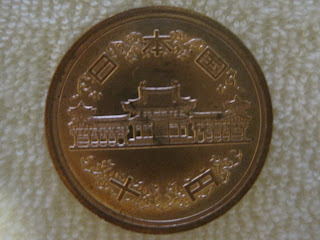replica in Hawaii
 Byodoin Temple was first established in 1052 when the Fujiwara clan converted their family villa into a temple. It was during the mid-Heian Period and is now one of the last surviving pieces of architecture of that time. The pure land garden with the Ajike Pond is also a great example of Heian design. The main building is called Phoenix Hall because of the two phoenixes flanking the center roof and the structure's resemblance to a phoenix spreading its wings. In the center of Phoenix Hall sits the seated statue of Amitabha Tathagata, made by Jocho, a Buddhist sculptor specializing in the assembled wood technique.
Byodoin Temple was first established in 1052 when the Fujiwara clan converted their family villa into a temple. It was during the mid-Heian Period and is now one of the last surviving pieces of architecture of that time. The pure land garden with the Ajike Pond is also a great example of Heian design. The main building is called Phoenix Hall because of the two phoenixes flanking the center roof and the structure's resemblance to a phoenix spreading its wings. In the center of Phoenix Hall sits the seated statue of Amitabha Tathagata, made by Jocho, a Buddhist sculptor specializing in the assembled wood technique.  The Phoenix Hall itself is a national treasure as well as the Amitabha Tathagata statue inside. There is a modern museum at the back of Phoenix Hall that houses relics and other national treasures including the original pair of phoenixes, Buddhist temple bell, and the fifty-two worshiping bodhisattvas on clouds. The modern architecture of the museum is a surprising contrast from the aged beauty of the temples on the grounds. Lines, framing, materiality, elegant simplicity, and the use of dark and light suggests traditional Japanese architecture and the concept of yugen. I think that this site is definitely worth a visit and that the modern museum adds a great visual contrast and a more in depth view into the history of the site. Directions to the site and more history and photos can be found at sacred-destinations.com.
The Phoenix Hall itself is a national treasure as well as the Amitabha Tathagata statue inside. There is a modern museum at the back of Phoenix Hall that houses relics and other national treasures including the original pair of phoenixes, Buddhist temple bell, and the fifty-two worshiping bodhisattvas on clouds. The modern architecture of the museum is a surprising contrast from the aged beauty of the temples on the grounds. Lines, framing, materiality, elegant simplicity, and the use of dark and light suggests traditional Japanese architecture and the concept of yugen. I think that this site is definitely worth a visit and that the modern museum adds a great visual contrast and a more in depth view into the history of the site. Directions to the site and more history and photos can be found at sacred-destinations.com. Byodoin Temple on the 10 yen coin
Byodoin Temple on the 10 yen coin

No comments:
Post a Comment